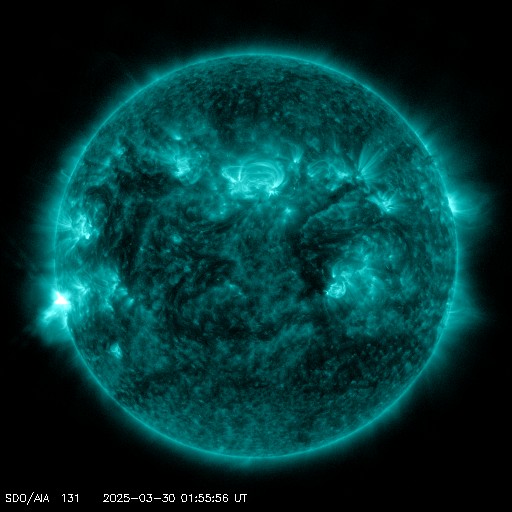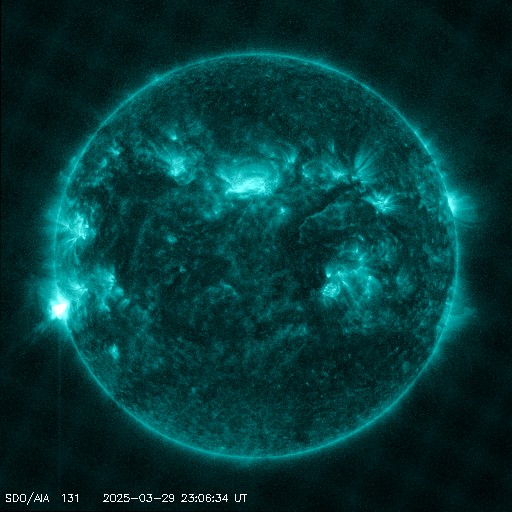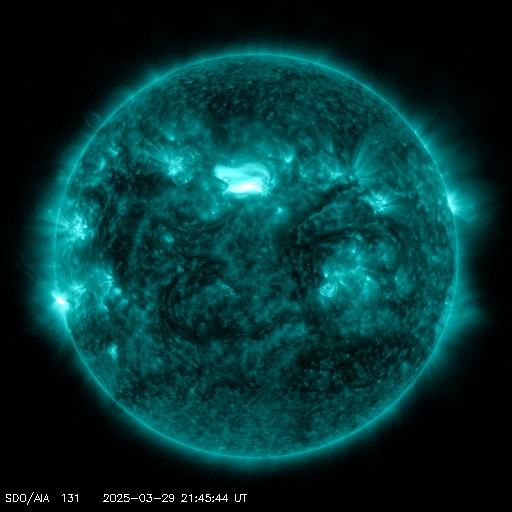Viewing archive of Friday, 11 May 2012
Solar activity report
Any mentioned solar flare in this report has a scaling factor applied by the Space Weather Prediction Center (SWPC). Because of the SWPC scaling factor, solar flares are reported as 42% smaller than for the science quality data. The scaling factor has been removed from our archived solar flare data to reflect the true physical units.
Report of Solar-Geophysical Activity 2012 May 11 2200 UTCPrepared by the NOAA © SWPC and processed by SpaceWeatherLive.com
Joint USAF/NOAA Report of Solar and Geophysical Activity
SDF Number 132 Issued at 2200Z on 11 May 2012IA. Analysis of Solar Active Regions and Activity from 10-2100Z to 11-2100Z
Solar activity has been at low levels for the past 24
hours with several C-class x-ray flares. Region 1476 (N10W06) was
the source for nearly all of the reported flares, with the largest
being a C6 that occurred at 11/1738Z. This region has remained
mostly consistent as an Fkc/beta-gamma-delta spot group, but has
shown some signs of decay, mainly in the trailer spots. New Regions
1479 (N15E65) and 1480 (S16W10) were numbered over the last 24
hours, are Hsx/Axx classifications respectively, and have yet to
show much activity.
IB. Solar Activity Forecast
Solar activity is expected to be at
moderate levels with a slight chance for X-class x-ray flares for
the next three days (12 - 14 May) as Region 1476 keeps its
Fkc/beta-gamma-delta configuration.
IIA. Geophysical Activity Summary 10-2100Z to 11-2100Z
The geomagnetic field has been at quiet to active levels for the past
24 hours. Solar wind measurements, as observed by the ACE
spacecraft, showed a fairly steady drop in speeds from approximately
650 km/s down to approximately 550 km/s. The effects of the coronal
hole high speed stream (CH HSS) should begin to wane over the next
24-48hrs. The total IMF remains fairly stable at approximately 5
nT. The greater than 2 MeV electron flux at geosynchronous orbit
reached high levels during the period.
IIB. Geophysical Activity Forecast
The geomagnetic field is
expected to be at quiet to unsettled levels for days one and two
(12-13 May), then return to quiet levels on day three (14 May).
III. Event Probabilities 12 May to 14 May
| Class M | 75% | 75% | 75% |
| Class X | 20% | 20% | 20% |
| Proton | 10% | 10% | 10% |
| PCAF | Green | ||
IV. Penticton 10.7 cm Flux
Observed 11 May 136 Predicted 12 May-14 May 130/130/130 90 Day Mean 11 May 113
V. Geomagnetic A Indices
Observed Afr/Ap 10 May 011/013 Estimated Afr/Ap 11 May 011/012 Predicted Afr/Ap 12 May-14 May 007/008-007/008-006/005
VI. Geomagnetic Activity Probabilities 12 May to 14 May
| A. Middle Latitudes | |||
|---|---|---|---|
| Active | 15% | 10% | 05% |
| Minor storm | 05% | 01% | 01% |
| Major-severe storm | 01% | 01% | 01% |
| B. High Latitudes | |||
|---|---|---|---|
| Active | 20% | 15% | 15% |
| Minor storm | 25% | 20% | 15% |
| Major-severe storm | 20% | 10% | 05% |
All times in UTC
Current data suggests there is a slight possibility for aurora to appear at the following high latitude regions in the near future
Gillam, MB, Yellowknife, NTFairbanks, AK
Latest news
Latest forum messages
AR4046 129AR4048 20AR4043 47Incoming & Unnumbered Active Regions 1658Aurora photography hints for those of us with smartphones 51
More topicsSupport SpaceWeatherLive.com!
A lot of people come to SpaceWeatherLive to follow the Sun's activity or if there is aurora to be seen, but with more traffic comes higher server costs. Consider a donation if you enjoy SpaceWeatherLive so we can keep the website online!

Latest alerts
02:09 UTC - Solar flare
Moderate M1.54 flare from sunspot region 4048
01:42 UTC - Radio Blackout
Minor R1 radio blackout in progress (≥M1 - current: M1.24)
Saturday, 29 March 2025
23:21 UTC - Solar flare
Moderate M1.91 flare from sunspot region 4048
22:51 UTC - Radio Blackout
Minor R1 radio blackout in progress (≥M1 - current: M1.1)
21:57 UTC - Solar flare
Moderate M1.45 flare from sunspot region 4048
Space weather facts
| Last X-flare | 2025/03/28 | X1.1 |
| Last M-flare | 2025/03/30 | M1.5 |
| Last geomagnetic storm | 2025/03/27 | Kp5 (G1) |
| Spotless days | |
|---|---|
| Last spotless day | 2022/06/08 |
| Monthly mean Sunspot Number | |
|---|---|
| February 2025 | 154.6 +17.6 |
| March 2025 | 127.5 -27.1 |
| Last 30 days | 127.5 -24.7 |





